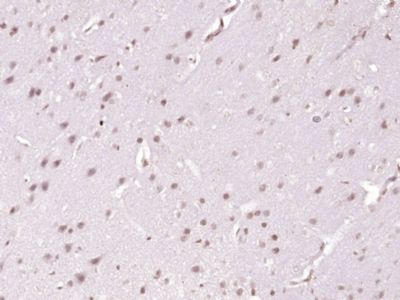产品货号 : mlR10266
英文名称 : TBX3
中文名称 : 转录因子Tbx3抗体
别 名 : T-box protein 3; T-box transcription factor TBX3; TBX3; TBX3-ISO; TBX3 ISO; UMS; XHL; Bladder cancer related protein XHL; T box 3; TBX3_HUMAN.
抗体来源 : Rabbit
克隆类型 : Polyclonal
交叉反应 : Human, Mouse, Rat, Dog, Pig, Cow, Horse, Rabbit,
产品应用 : ELISA=1:500-1000 IHC-P=1:400-800 IHC-F=1:400-800 Flow-Cyt=3ug/test ICC=1:100-500 IF=1:100-500 (石蜡切片需做抗原修复)
not yet tested in other applications.
optimal dilutions/concentrations should be determined by the end user.
分 子 量 : 82kDa
细胞定位 : 细胞核
性 状 : Lyophilized or Liquid
浓 度 : 1mg/ml
免 疫 原 : KLH conjugated synthetic peptide derived from human TBX3:101-200/743
亚 型 : IgG
纯化方法 : affinity purified by Protein A
储 存 液 : 0.01M TBS(pH7.4) with 1% BSA, 0.03% Proclin300 and 50% Glycerol.
保存条件 : Store at -20 °C for one year. Avoid repeated freeze/thaw cycles. The lyophilized antibody is stable at room temperature for at least one month and for greater than a year when kept at -20°C. When reconstituted in sterile pH 7.4 0.01M PBS or diluent of antibody the antibody is stable for at least two weeks at 2-4 °C.
PubMed : PubMed
产品介绍 : Tbx3 gene is a member of a phylogenetically conserved family of genes that share a common DNA binding domain, the T box. T box genes encode transcription factors involved in the regulation of developmental processes. Tbx3 is a transcriptional repressor and is thought to play a role in the anterior/posterior axis of the tetrapod forelimb. Mutations in this gene cause ulnar mammary syndrome, affecting limb, apocrine gland, tooth, hair, and genital development. Alternative splicing of this gene results in three transcript variants encoding different isoforms; however, the full length nature of one variant has not been determined.
Function:
Transcriptional repressor involved in developmental processes. Probably plays a role in limb pattern formation.
Subcellular Location:
Nucleus (Potential).
Tissue Specificity:
Widely expressed.
DISEASE:
Defects in TBX3 are the cause of ulnar-mammary syndrome (UMS) [MIM:181450]. UMS is characterized by ulnar ray defects, obesity, hypogenitalism, delayed puberty, hypoplasia of nipples and apocrine glands.
Similarity:
Contains 1 T-box DNA-binding domain.
SWISS:
O15119
Gene ID:
6926
Important Note:
This product as supplied is intended for research use only, not for use in human, therapeutic or diagnostic applications.
产品图片












